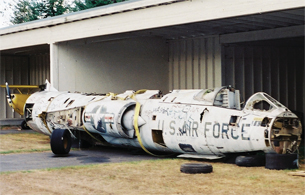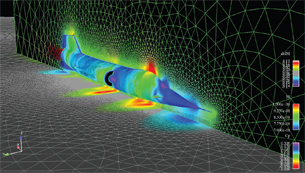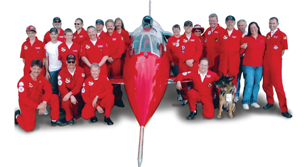Going for the Record with Lenovo and Dassault Systèmes
A team of North American engineers attempts to break the land-speed record with help from many sponsors.
Latest News
December 4, 2001
By David Cohn
 The NAE “car” was converted from an F-104 Starfighter Air Force jet purchased in 1998 for $25,000. |
Speed. For 20 years, Americans held the land-speed record, the fastest speed achieved by a wheeled vehicle on land. But in October 1983, Richard Noble of the UK set a new mark of 633 mph in Thrust2. Fourteen years later, Noble returned to the Black Rock Desert in northwestern Nevada with a new vehicle, ThrustSSC. On Oct. 15, 1997, exactly 50 years and 1 day after Chuck Yeager broke the sound barrier in the Bell X-1 research plane, Royal Air Force pilot Andy Green not only achieved a new record of 763 mph, but ThrustSSC became the first land vehicle to officially break the sound barrier.
That same year, Ed Shadle, after retiring from a management position at IBM, turned his attention to his dream of bringing the land-speed record back to North America. Shadle has always dreamed of going fast. At the age of 14 he built a Soapbox Derby racer. In his teens he raced hot rods. Even as an adult his fascination with speed continued, with stints racing motorcycles, and working as a crew chief and then an owner/driver on the Bonneville Salt Flats.
Together with Keith Zanghi, a manager at Boeing, Shadle formed North American Eagle (NAE) with the single purpose of breaking the existing record by reaching 800 mph. Not only does the task pose myriad engineering challenges, NAE’s approach has been unique. Where the ThrustSSC team had significant financial backing, NAE has operated with a team of volunteers and a growing collection of sponsors who have contributed everything from computers and software to a bus used to transport team members to testing sessions in the Nevada desert.
And while previous land-speed record vehicles have been designed from the ground up, Shadle and Zanghi’s venture stands out as the first to create a car from the fuselage of a former jet fighter. In September 1998, the team purchased a “junked out” F-104 Starfighter for $25,000 and had it shipped from Maine to the team’s headquarters in Spanaway, WA.
Making the Dream a Reality
Getting the F-104 was just the start. Shadle and Zanghi had to reverse engineer the fuselage and figure out how to keep it stable on the ground at speeds of Mach 1 (761.2 mph). The team had to design special wheels that could withstand speeds of more than 15,000 rpm. A braking system was needed that could slow the vehicle without burning up. And the vehicle needed a steering and suspension system that would be strong and stable at incredibly high speeds.
“You have not only lifting forces but you also have crushing forces,” Shadle explained. “You have to find the neutral point.”
 Computational fluid dynamics (CFD) is used to study the transonic shockwaves that will begin developing around the North American Eagle vehicle as it approaches the speed of sound. |
When they began, Shadle and his team had no CAD software. But at an aerospace testing and design conference in Anaheim, CA, in 2006, Shadle struck up a conversation with a representative from Dassault Systèmes. That chance meeting led to Dassault’s involvement as a technical sponsor, providing the NAE team with copies of its CATIA V5 software. After being invited to give a presentation at a Dassault Systèmes event in Paris, a similar chance meeting resulted in Lenovo also signing on as a technical sponsor, equipping the team with ThinkStation workstations. FARO Technologies joined, providing its scanning devices, and Geomagic signed on with its digital shape sampling and processing (DSSP) software.
Other chance encounters added more expertise. Mike Thoe from Boeing’s Aerodynamics Laboratory happened to be visiting NAE on a tour with his local Model A Ford club. He came back with Rex Walter and Ron Doll, two other Boeing aeronautical engineers. The three now have the task of stabilizing the Eagle at speed. They also put the NAE team in touch with the people who run the Cray supercomputer at the National Center for Computational Sciences in Oak Ridge, TN.
North American Eagle used a FARO Photon Laser scanner to capture the entire 56-foot long Eagle vehicle as a point cloud containing 30 million points. Geomagic Studio, running on a Lenovo ThinkStation D10 workstation, was then used to transform the scan data into a surface model that could be brought into the CATIA V5 software. The Boeing engineers then ran computational fluid dynamics (CFD) and finite element multiphysics analysis based on that CATIA model to evaluate transonic shock waves that will begin developing around the Eagle vehicle at speeds starting at Mach 0.7. These shock waves can change the vehicle’s aerodynamics, leading to destabilizing lift and lateral movement. “When you go transonic, then what was a crushing force can become a lifting force,” said Shadle. “It’s a fine dance.”
As a result, the engineers designed and installed canards on each side of the cockpit to counteract ground effects and lifting forces. Load sensors will gather information and an on-board computer will monitor changes in attitude and make adjustments faster than the driver can react.
The Eagle vehicle also has 16 air pressure ports. Each time the team does a test run, data from the air pressure ports as well as 75 other data channels is captured on a solid-state drive. Images from an Olympus high-speed camera capture vehicle performance at up to 33,000 frames-per-second and three Ecliptic Enterprises RocketCAM high-resolution cameras, the same cameras used on the Space Shuttle, capture real-time detail.
 Members of the all-volunteer North American Eagle team are currently funding 90 percent of operations from their own pockets while a search for a major financial sponsor continues. |
Crucial Parts Designed in CATIA
After the test run, the data and images are downloaded to a Lenovo workstation so they can be incorporated into the team’s analysis work. All of this helps NAE engineers validate and match the real-time information to the information they’re creating in the CATIA virtual model and aids in fine-tuning the aerodynamic stability of the vehicle as well as its wheel, suspension, and braking systems designs.
The wheels proved to be a challenge. The first wheels Shadle built were no good above 600 mph. The Eagle actually has three different types of wheels. The two wheels in the middle of the vehicle act “like roller skates,” explained Shadle. “They have to just carry so much weight. But at the top end they’ll run at close to 15,000 rpm.” The front wheel will reach 12,000 rpm, but because it is also the steer wheel, it must be able to withstand lateral forces as well. And the rear wheels, in addition to supporting the vehicle, are also part of the braking system.
The team considered designs that combined titanium and aluminum, but FEA software running on the Lenovo multicore ThinkStation D10 workstation revealed that at the speeds the wheels would reach, the titanium would expand faster than the aluminum and the wheels would fail. Virtual testing also revealed that centrifugal forces would cause the bearings to loosen.
“We discovered that the hole in the wheel couldn’t be any larger than three inches in diameter or it would compromise the integrity of the entire wheel,” said Shadle.
It took more than a year to finalize the design. Ultimately, each wheel was machined from a single forging of aerospace-grade aluminum and designed to be safe up to 850 mph.
Then there’s the task of slowing and stopping the Eagle after reaching an 800 mph record run. The original mechanical disc brakes, wheels, and related assemblies burned up completely in one 312 mph test run after the brakes reached a temperature of 800°F. According to Zanghi of Boeing, “Other than a lot of smoke and heat, no one was injured.”
To redesign the brakes, NAE engineers evaluated many designs and agreed on a noncontacting magnetic brake design patented by LEVX Technology. The system uses 27 rare earth magnets on the caliper of each rear wheel. Three hydraulic cylinders move the calipers into close, yet noncontacting, proximity to the aluminum rotors. When the rotors move past the magnets, they excite electrons in the aluminum, setting up powerful eddy currents. The higher the speed, the stronger the magnetic force. The magnetic brakes account for 50 percent of the braking force. In June 2008, the 14,000-pound Eagle was stopped from a speed of 400 mph in one mile using nothing more than the LEVX brakes. The brakes reached 625°F in that test, but the newly designed rear wheel and brake assembly can withstand temperatures up to 1200°F.
To stop the car at the end of a record run, speed brake doors that are part of the original F-104 will deploy outward on each side of the vehicle. When the car slows to about 650 mph, a drogue chute will be ejected from underneath. Once the vehicle slows to about 500 mph, the main chute will be deployed. When the vehicle slows enough, the magnetic brakes on the rear wheels can be applied. If all or part of these systems fails, the driver can then steer the Eagle into an aircraft carrier catch net, which has been tested to 300 mph.
Practical applications
As if the physics involved at supersonic speeds aren’t daunting enough, the other statistics surrounding the Eagle are equally impressive. As an aircraft, the F-104 reached speeds of 1,500 mph. The Eagle is powered by the same type of J-79 turbojet, capable of generating 18,200 pounds of thrust.
In full afterburner at top speed, the engine consumes 2.6 gallons of fuel every second. In five miles it burns 160 gallons. That works out to 31 gallons per mile or about 165 feet per gallon. The team is experimenting with biofuels and reducing hydrocarbon emissions from the engine.
To break the current record, Shadle must surpass the previous mark by at least 1 percent, meaning he must reach a speed of 771 mph. The North American Eagle team plans to do test runs in 2009 at speeds of 400 to 600 mph to evaluate recent design changes. This “small steps process” is being followed partly for safety and partly because without a major sponsor, Shadle and his team are still funding nearly 90 percent of the operation from their own pockets. The NAE team hopes to make a land-speed record attempt on July 4, 2010.
In addition to the record, there are practical lessons to be learned from the technologies being developed. Results from the team’s parachute deployment tests can be used in the design of spin recovery chutes for fighter aircraft. Aerodynamic tests will help shed light on the performance of high-speed surface vehicles, such as high-speed rail transport. And the magnetic braking system has a multitude of applications, from noncontact, non-wearing torque converters, clutches, and brakes to the use of newly developed alloys that can be applied to improve the safety and strength of high-mileage vehicles that run on alternative fuels or other propulsion systems.
While sponsors like Dassault Systèmes, FARO, Geomagic, and Lenovo clearly see benefits in their participation, who wouldn’t want to be part of the team that sets the new land-speed record?
More Info
Cray
Seattle, WA
Dassault Systèmes
Paris, France
Ecliptic Enterprises
Pasadena, CA
FARO Technologies Inc.
Lake Mary, FLA
Geomagic
Research Triangle Park, NC
Lenovo
Morrisville, NC
LEVX Technology
Port Angeles, WA
Olympus
Center Valley, PA
Contributing Editor David Cohn is a computer consultant and technical writer based in Bellingham, WA, and has been benchmarking PCs since 1984. He’s the former editor-in-chief of Engineering Automation Report and CADCAMNet, and the author of more than a dozen books. Please send comments about this article to [email protected]. You can also contact David at [email protected].
Subscribe to our FREE magazine, FREE email newsletters or both!
Latest News
About the Author
David Cohn is a consultant and technical writer based in Bellingham, WA, and has been benchmarking PCs since 1984. He is a Contributing Editor to Digital Engineering, the former senior content manager at 4D Technologies, and the author of more than a dozen books. Email at [email protected] or visit his website at www.dscohn.com.
Follow DE





